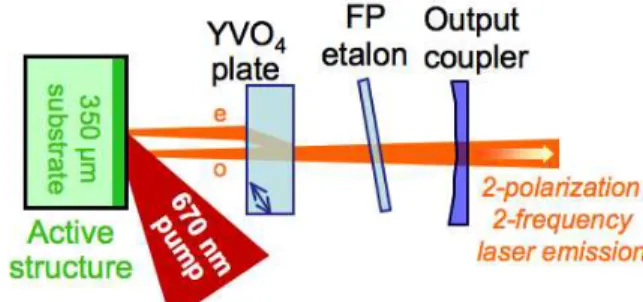HAL Id: hal-00734196
https://hal-iogs.archives-ouvertes.fr/hal-00734196
Submitted on 21 Sep 2012
HAL is a multi-disciplinary open access
archive for the deposit and dissemination of
sci-entific research documents, whether they are
pub-lished or not. The documents may come from
teaching and research institutions in France or
abroad, or from public or private research centers.
L’archive ouverte pluridisciplinaire HAL, est
destinée au dépôt et à la diffusion de documents
scientifiques de niveau recherche, publiés ou non,
émanant des établissements d’enseignement et de
recherche français ou étrangers, des laboratoires
publics ou privés.
Dual frequency emission in a compact semiconductor
laser for coherent population trapping cesium atomic
clocks
Fabiola Camargo, Patrick Georges, Gaëlle Lucas-Leclin, Nils Girard, Ghaya
Baili, Loïc Morvan, Daniel Dolfi, David Holleville, S. Guérandel, Isabelle
Sagnes
To cite this version:
Fabiola Camargo, Patrick Georges, Gaëlle Lucas-Leclin, Nils Girard, Ghaya Baili, et al.. Dual
fre-quency emission in a compact semiconductor laser for coherent population trapping cesium atomic
clocks. 5th EPS-QEOD EUROPHOTON CONFERENCE ”Solid State, Fibre, and Waveguide
Coher-ent Light Sources”, Aug 2012, Stockholm, Sweden. �hal-00734196�
5th EPS-QEOD EUROPHOTON CONFERENCE "Solid State, Fibre, and Waveguide Coherent Light Sources"
Dual frequency emission in a compact semiconductor laser for coherent
population trapping cesium atomic clocks !
F. A. Camargo1, P. Georges1, G. Lucas-Leclin1,
N. Girard2, G. Baili2, L. Morvan2, D. Dolfi2, D. Holleville3, S. Guerandel3, I. Sagnes4
1. Laboratoire Charles Fabry, Institut d'Optique, CNRS, Univ Paris-Sud XI , 2 Av. A. Fresnel, 91127, Palaiseau, France
2. Thales Research & Technology, 1 Av. A. Fresnel, 91767, Palaiseau, France
3. LNE-SYRTE, Systèmes de Référence Temps-Espace, Observatoire de Paris, CNRS, UPMC , 61, Av. de l’Observatoire, 75014 Paris, France
4. Laboratoire de Photonique et de Nanostructures, CNRS, Route de Nozay, 91460, Marcoussis, France
Coherent population trapping (CPT) has been demonstrated as an interesting technique for miniature atomic frequency references [1,2] and quantum information. It is based on the coupling of the two hyperfine ground states of an alkali atom – namely cesium (133Cs) for atomic clocks – through excitation to a common atomic level by two phase-coherent laser fields nearly resonant with the atomic transitions. The frequency difference between the two laser fields is tuned at the atomic frequency splitting in the microwave range, equal to 9.192 GHz for 133Cs atoms. Outputs powers in the mW range and narrow-linewidth emission (<500 kHz) are required for the two laser beams. Dual-frequency operation of an optically-pumped vertical external cavity semiconductor laser (VECSEL) has been proposed as a simple and compact solution [3] and presents many advantages. First, this configuration takes benefit of the intrinsically strong correlation between the two laser lines which share the same cavity; second, the frequency difference, which is proportional to the intracavity phase anisotropy, may be tunable from few tens of MHz to a few THz. Finally, the low relative-intensity-noise of VECSELs on a wide spectral range is of particular interest for this application, as it should provide a high-purity RF beat-note phase spectrum.
The laser cavity was composed by a semiconductor chip and a 15mm concave output mirror with a transmission of 0.5% at 852 nm. In order to obtain two cross-polarized adjacent longitudinal modes distanced by 9.192 GHz, a 10-mm long compact cavity was designed, corresponding to a free-spectral-range of 12 GHz. The semiconductor chip is grown on a 350 !m-thick GaAs substrate and it comprises 7 GaAs quantum wells embedded in Al20%Ga80%As barriers grown on a high-reflectivity Bragg mirror [4]; it is pumped with a
fiber-coupled laser diode emitting up to 1 W at 670 nm. The dual frequency emission is achieved thanks to a 500 !m-thick birefringent YVO4 plate which induces a lateral separation of 50 !m of the ordinary and extraordinary
polarizations in the semiconductor chip. An uncoated silica etalon is used to tune the central wavelength and to force the single-frequency emission at each polarization. The laser cavity design has focused on compactness as well as high mechanical and thermal stability. The pump optics, the semiconductor chip and the laser cavity elements are integrated in a compact casing. This limits mechanical and acoustic vibrations as well as air temperature fluctuations inside the external cavity. The temperature of the whole setup is stabilized to 15°C with a Peltier element.
Fig. 1!"#$%&'$()*+,-$).#,/0,)1$,2.*+,0%$3.$(45,6!78!9:,
The maximum output power reaches 10 mW on each polarization with all the elements in the cavity. The dual-frequency emission is evidenced in the RF beat-note spectrum obtained by mixing the cross-polarized lines. Finally, the laser line is stabilized onto an atomic hyperfine transition of the Cs D2 line at
852.14 nm; the laser frequency at the ordinary polarization is locked to the side of a Doppler-free saturated absorption line through a low-bandwidth (f <1kHz) servo loop on the piezoelectric transducer glued onto the output coupler.
In the next future, the addition of an intracavity electro-optic modulator will allow to phase-lock the frequency difference "# at 9.2 GHz and to stabilize it to Cs hyperfine splitting.
References
[1] J. Kitching, et al, “A microwave frequency reference based on VCSEL-driven dark line resonances in Cs vapor” IEEE Trans. Instrum.
Meas. 49, 1313 (2000).
[2] T. Zanon et al, “High Contrast Ramsey Fringes with Coherent-Population-Trapping Pulses in a Double Lambda Atomic System” Phys.
Rev. Lett. 94, 193002, (2005).
[3] G. Baili, L. Morvan, M. Alouini, D. Dolfi, F. Bretenaker, I. Sagnes and A. Garnache, “Experimental demonstration of a tunable dual-frequency semiconductor laser free of relaxation oscillations”, Opt. Lett. 34, 3421 (2009).
[4] B. Cocquelin et al, "Tunable Single-frequency operation of a diode-pumped Vertical-External Cavity Laser at the Caesium D2 line",
